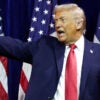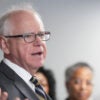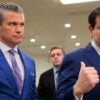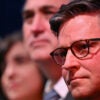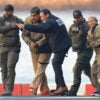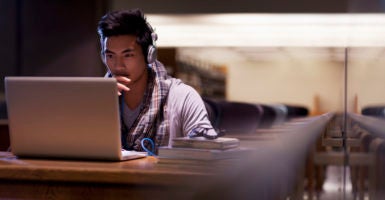“Through our lessons and our presence, albeit in a digital way, we can provide our students with a reassuring voice and a sense of the known, as we explore the unknown together,” says Aaron Dominguez, provost and physicist at the Catholic University of America.
Across the country, students of all ages are being sent home to continue their studies at a distance from school (and from each other). At my own university, Catholic University of America, students are now working remotely for the rest of the school year. How does this education work and is it effective?
Remote learning and credentialing are older than our republic. As the story goes, a 17-year-old George Washington earned his surveyor’s license by mail from the College of William & Mary in 1749.
According to Wikipedia, Washington was hardly the first remote student in America. In 1728, the Boston Gazette posted an announcement, “Caleb Philipps, Teacher of the new method of Short Hand,” for students looking for the convenience of correspondence courses. The University of Toronto offered the first class offered entirely online in 1984.
Today, there is more content and at lower cost. Over the past two decades educators have refined the art, craft, and practice of online learning. I have been building and delivering online instructional material for almost a decade. We have learned (or have been reminded) that the student’s learning experience is interconnected in three areas: with the course materials, other students, and the teacher.
In graduate school I did study abroad in Oxford. It was a living history with very old libraries and large, heavy books—books that were chained to massive tables. The books (and the knowledge therein) were so valuable that our medieval predecessors knew how to keep a book on reserve. For centuries.
The internet changes, well, everything. Content is free or nearly so online. Experts flock to share knowledge and expertise at no charge to anyone with internet access. Publishers of academic textbooks are able to provide value with rigorous web-based evaluations. These instruments test the student’s retention of the course material and are easy to administer by faculty.
A school system’s online education is conducted in a virtual classroom where peer-to-peer communication drives the sharing of knowledge.
Just because classes are conducted online doesn’t mean there isn’t interaction among students and professors.
Advanced online learning curriculum have discussion and responsive comment forums. These are similar to the familiar chat rooms—but hopefully with more civilized behavior. Common software solutions have simple forums where students post extended essays and then post comments on other students’, leading to a discussion.
Everyone participates. Each student contributes. These forums and class discussions are moderated and guided by the faculty who act as facilitators evaluating the contributions.
This class “participation” also serves as “attendance” where peer-to-peer conversations are encouraged and recorded.
There are no back rows in online classrooms goes the cliché. Whereas some students might be distracted or worse in the class (not my students, mind you … ), hiding is not possible online.
The discussion contributions and the conversations of the individual students are graded on the quality of contribution and to encourage the student to move the conversation. In fact, the best online class size will have fewer students than its in-person counterpart.
These interactions—the three-way feedback loop, student-content-teacher—is the driver for learning in the digital world as we have seen in generations past.
George Washington might be our most famous distant learner. Before he died, Washington not only became our first president, but was also chancellor of the College of William & Mary—showing that there’s no need for an online education to be a second-class one.
